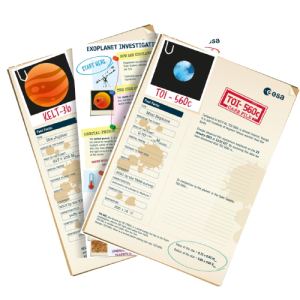
Step 5 – Composition
In our Solar System, planets are usually divided into two categories: rocky and gaseous. However, exoplanets can be very different from the neighbouring planets we


In our Solar System, planets are usually divided into two categories: rocky and gaseous. However, exoplanets can be very different from the neighbouring planets we

Step 4 – Temperature and Habitability To this day, Earth is the only place in the universe that is known to host life. It is

Step 3 – Orbital Period and Distance The orbital period, T, of a planet is the time it takes the planet to complete one full

The depth of the exoplanet transit is equivalent to the ratio of the area of the planet’s disc and the area of the star’s disc.

To complete your casefile and profile mysterious exoplanets you need to select your target and access the Cheops satellite data. If this is the first

Download the Educator Guide and the Casefiles Brief description: In this activity, students will characterise mysterious exoplanets by analysing data acquired by ESA’s Cheops satellite.